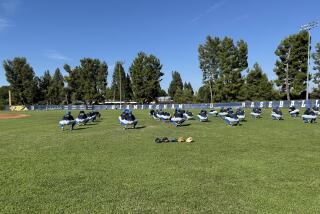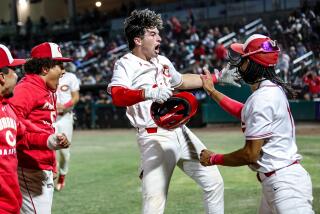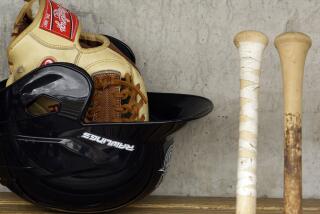Diamonds in the Rough : High School baseball Fields in the Area Have Characters All Their Own
The one thing you can say about a football field or basketball court is that there are few surprises. You expect 100 yards, you get 100 yards. You look up 10 feet, you know there’s a hunk of metal waiting for you.
Dependable. Boring.
Where’s the swimming pool like the one that acts as the right field foul line and also shags fly balls ( splash ) at Loara High? Where are the overhanging trees (La Habra), the chicken coop (Fullerton), the short porches, the deep caverns. . . . Ladies and gentlemen, where is the character?
If there is one area in which high school baseball, the poor cousin of football and basketball in attendance, can surpass the others, it is at grounds level. Look around. There are tall fences, short fences, non-fences and fences that go boom. There are hitters’ fields and pitchers’ nightmares (“Did someone feel a breeze?”). There are embankments (University) that have been known to cause a player to lose his footing and eat dirt. And there is a large divot at Huntington Beach that has been known to swallow players whole.
Anything goes. Anything the surrounding streets and the rest of the school property will allow. Baseball fields are many times wedged into what space is available. Because there are no rules governing configuration, anything is acceptable--including the distance of 230 feet to the right-field fence at Laguna Beach High, nearly 100 feet less than on most fields.
And then there are the natural laws that seem to affect baseball as much as or more than most sports.
Every Orange County high school baseball field is unique. Here’s a few that, by their configurations, may border on the bizarre.
FENCED IN
Huntington Beach Coach Mike Dodd strolls onto the Oilers’ field past the left-field fence almost every day. He doesn’t want to, but it’s the only entrance.
As he enters, Dodd glares at the fence, which is 40 feet high and 274 feet from home plate. He can’t be sure, but Dodd thinks sometimes the fence glares back.
“That thing is a monster,” Dodd said. “It’s the Fenway Park of Orange County, but it’s not very loyal to the home team. I sometimes go out and hit balls against it, just to show it how I feel.”
Simply put, Dodd doesn’t care for the design of Huntington Beach’s baseball field. You really can’t blame him.
A few years ago in the Southern Section 5-A playoffs, Huntington Beach was leading Camarillo, 3-0, with two out in the seventh inning. A couple of walks and a single made it 3-1. Still just one out to go, still a comfortable lead.
And then . . .
“A guy hits a fly ball, just a regular fly ball. It goes over the Monster,” Dodd said. “We’re ready to celebrate and then we lose. It was just that quick.
“And then the ball rolls back under the fence--like the Monster was spitting it out--just like it was showing me. It wasn’t the first time that thing has taken a game away from us.
“Seems like every time something happens out there, it happens against Huntington Beach.”
Losing a ballgame may be maddening, but losing an outfielder is something out of a Stephen King novel.
“About four years ago, Jeff Crogan was playing left field,” Dodd said. “There was a fly ball that the wind took toward the Monster. Now, right at the drop-off to the smaller fence, there’s kind of a hole. Jeff kept going back and tripped in the hole.
“From our vantage point, it looked like he disappeared into the earth. I thought to myself, ‘The Monster had taken so many games from me, now it had taken my left fielder.’ I kept waiting for him to emerge. We ran out there and when we got closer all you could see was his cleats sticking up in the air. It was like ‘Jaws 15.’ ”
Although the Monster can be unforgiving, the makeshift left-field fence at University literally will bend over backward to help an outfielder. Made out of plastic pipe and tarp, the fence has been known to be toppled by a stiff breeze, not to mention a back-peddling ballplayer.
Three years ago, a Saddleback outfielder, chasing a fly ball to left, caught the ball as he ran into the fence . . . make that, ran over the fence.
The fence fell, as did the outfielder--still holding the ball. Saddleback Coach Bob Mangram remembers a lengthy discussion about the ruling--the kid had caught the ball, but was the ball in play when he caught it?
A few minutes later, it was ruled an out. The fence was put back up and the game resumed.
PLAYING IT BY EAR
The makeup of Laguna Beach’s field is an outfielder’s nightmare. In left field, there is a maintenance shack and batting cage, but no fence. In left-center, the track surrounding the football field is a measly 290 feet from home plate. In right-center, where the field ends, the asphalt begins.
Before each game, Laguna Beach Coach Scott Magers goes over the ground rules with the umpires and opposing coach. At times, he says, it’s futile.
“It’s impossible to go over everything that could happen,” Magers said. “You just have to play the game, and, if something comes up that wasn’t covered, you deal with it then.”
Basically, everything is live. That is, unless the ball lands on the shed or batting cage in left. Then it’s a home run.
But everything else is live. That is, unless a track athlete touches the ball in left-center. Then it’s a ground-rule triple.
But everything else is live. Especially in right-center. When the ball hits the asphalt, it’s gone. Usually, no matter how slow the runner is, it’s going to be a home run.
“The ball will roll all the way across campus,” Magers said.
Said Jack Hodges, Laguna Hills coach: “Sometimes it seems that the ground rules are made up ex post facto . It makes for a lot of ground-rule doubles.”
Of course, there are hazards and then there are hazards . In 1979, Mission Viejo was playing at Laguna Beach as a track meet was in progress. Center fielder Greg Davis not only was trying to keep his mind on the game but was monitoring the discus competition behind him. This was easy since the discuses were landing in front of him.
“Greg looked like he was going crazy,” Mission Viejo Coach Ron Drake said. “He kept looking over his shoulder and discuses kept flying past him. They weren’t going to stop the track meet and we weren’t going to stop the baseball game.”
When Drake waved to position Davis for a hitter, he got a variety of hand signals in return.
“Greg was shaking his head, waving his arms, pointing at the ground,” Drake said. “He wasn’t going anywhere.”
Saddleback High has fences this season. Before that, there was nothing but wide-open spaces from left center to the right-field line. Beyond the grass of left center were basketball courts. Asphalt basketball courts.
“You played deep and hoped it didn’t get by you,” Mangram said. “I liked it, but only when we were batting. The ball would just roll and roll and roll.”
Mangram, concerned that kids chasing balls over the asphalt in cleats were susceptible to falling, devised that a ball hit onto the asphalt was a home run, and a ball rolling onto the asphalt was a ground-rule triple.
“We’d go over the ground rules before the game and Bob would say, ‘Anything that is hit onto the asphalt is a home run and anything that rolls onto the asphalt is a triple,’ ” said Jerry Jelnick, Corona del Mar coach. “I would stand there and nod my head, but I couldn’t even see the asphalt.”
The first that University infielder Casey Simpson heard of the rule was last year, when it cost him a home run in a crucial Sea View League game. Simpson hit a ball that bounced just short of the asphalt, then started to roll. He was halfway to home plate when the umpire directed him back to third.
“I looked up and their guy is still chasing the ball,” said Simpson, a senior. “It was crazy. The ball hit a foot or two from the asphalt. It was a home run at most fields.”
Simpson didn’t score, and University lost the game in extra innings.
“Casey hit that forever,” University Coach Steve Ruiz said. “It was well over 400 feet on the fly. But the Saddleback kid was smart. As soon as it touched the asphalt, he threw up his hands.”
NATURE TAKES A HAND
Players walk onto Laguna Hills’ baseball field and smile. Hawk Coach Jack Hodges has seen them. Always, their attention is drawn to the center-field fence, marked 300 feet.
“You can hear opposing players mumbling under the breath, ‘This is going to be my day,’ ” Hodges said. “They see that fence and think it’s going to be home-run derby. But there are probably less home runs hit here than in any other park in our area.”
The reason is the wind. Situated on the edge of a 20-foot embankment, with a valley beyond, Laguna Hills’ field receives a generous breeze that blows straight in from center field. It’s about the only advantage a pitcher has at the park.
“If you hit something hard on a line, it’s going to get out,” Hodges said. “But the wind will take 50 feet off most balls hit in the air.”
As a junior at Irvine in 1985, Bob Hamelin twice hit balls that appeared headed out. Both times, center fielder Chad Miller drifted back to the fence and simply waited for the balls to come down for outs.
“I thought they were out,” Hodges said. “(Irvine Coach) Bob Flint thought they were gone. I even think Miller thought they were gone. But that wind is about 15-20 miles per hour. Both were just routine outs.”
But then there are those three or four days a year that the wind shifts. One was during a game against San Clemente in 1983. There were eight home runs hit.
“Last week in practice, the wind was blowing out and we lost 15 baseballs,” Hodges said. “You just pray that the wind doesn’t shift on a game day, otherwise you’re in for a wild day.”
At Dana Hills, it’s an odd day when the wind doesn’t blow out. The school’s baseball field sits in the middle of a natural wind tunnel, created by onshore winds that gust through a ravine. It makes for clear skies and free rides for balls hit to left field.
“From center to left, the balls seem to jump out of there,” Drake said. “Right field isn’t any farther, but the wind just blows to left, and home runs fly out of there.”
Bob Canary, Dana Hills coach, said he thinks the whole thing is “overplayed.” But the fact remains that the Dolphins hit 19 home runs in their first 11 games. In 1985, they hit 28 home runs.
“There are days when it gets windy up there and the balls get caught up in the wind and they go,” he said. “But I don’t think the wind is usually a factor.”
There are probably a few pitchers who would beg to differ.
LAUNCHING PADS
Troy installed 10-foot-high outfield fences this season. One reason was to prevent kids from impaling themselves on the rusty 4-foot fences. Another was to protect people nearby. The left-field fence, a stone’s throw at 300 feet, lies in front of a soccer practice field.
“Every time we hit one out, seemed we decked a kid playing soccer,” Troy Coach Dan Robinson said.
Troy’s field is, in a word, cozy. It’s 302 to right, 357 to center. If you’re a hitter, this is kind of like Fantasyland. Sometimes. Robinson said big eyes usually lead to big from-the-ankle swings.
“We played Alhambra last season in the playoffs and they got a look at those fences and they cut loose,” he said. “They swung at everything, trying to hit it out.”
Troy won the game, 14-0.
For that reason, Robinson has stopped the Troy tradition of home-run competitions during batting practice. Still, boys will be boys, and balls do still pass over the fences at a rapid rate.
“If you’re a pitcher, you can’t be too happy about the way they set up that field,” Robinson said.
If you’re Servite Coach Mike McNary, and every penny counts, you can’t be too happy when your players hit balls out of your bandbox of a field at an alarming exchange rate. Servite’s field is 306 to left, 306 to center and 320 to right.
Balls so frequently flew out from left field and onto residential lawns that McNary has batting practice pitched with rubber balls that he says don’t carry as well. Also, batters stand well behind home plate when hitting.
“We put them as close to the backstop as we can get them,” he said.
Still, there was a session this season when 18 balls said bye-bye.
As far as grounds are concerned, nothing, but nothing, tops the Ma and Pa Kettle surroundings of Fullerton High.
For years, there were cows and pigs in center field, moving barnyard targets just 313 feet away. The chicken coop remains in left, 308 feet away. It’s a hitter’s park, which Fullerton, through the years, has exploited to the max.
Under Dave Torres, who left this season to coach at Anaheim after five seasons at Fullerton, the Indian hitters got anywhere from 250 to 300 balls to hit each practice.
“Our philosophy was, this was a great park to hit in, so we might as well hit,” he said.
Torres learned this from his coach at Fullerton, Gene Martin.
“We hit all the time,” Torres said. “We were proud of our field, the way it looked. It looks like something out of the Midwest.”
More to Read
Go beyond the scoreboard
Get the latest on L.A.'s teams in the daily Sports Report newsletter.
You may occasionally receive promotional content from the Los Angeles Times.











